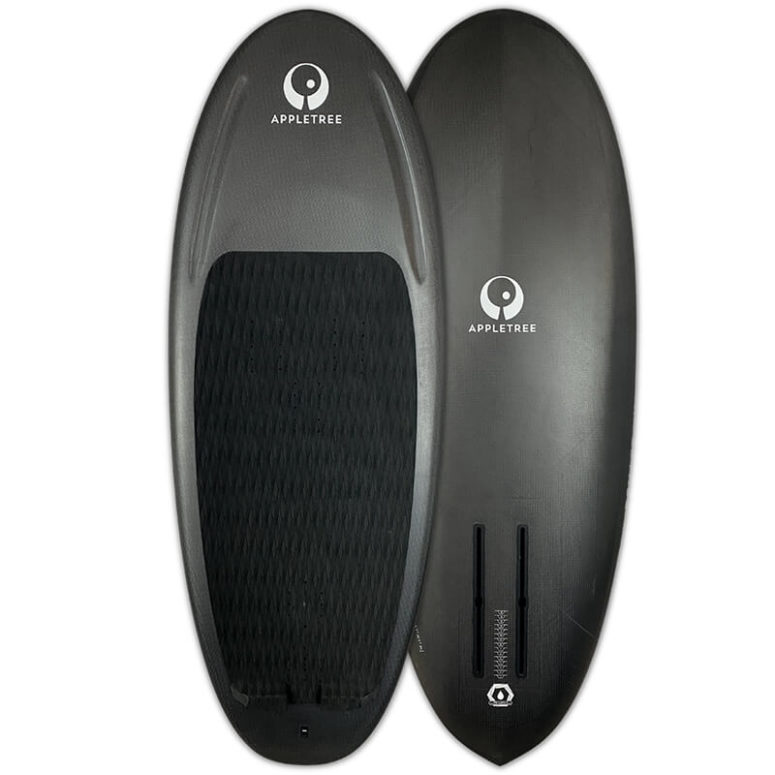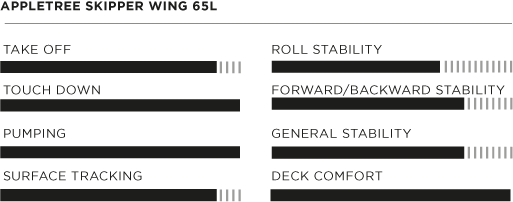

When you purchase gear through links on our site, we may earn a small commission. Here’s why you can trust our tests and our affiliate partner.

The original round of wing board designs started off looking pretty boxy and clunky, but we’ve come a long way in a few short years with designs gradually smoothing out and turning into far more streamlined and I daresay traditional and elegant shapes. Harsh chines and stepped tails are disappearing and fast becoming old tech.
The Apple Skipper Wing epitomizes this evolution and has extremely smooth lines drawn from the rest of the Skipper board range, which includes downwind, wing, prone and short models. The whole series is more along the lines of a performance yacht, sporting more of a displacement hull rather than planing hull. The outline places the bulk of volume up front and below the front foot, and tapers back to an efficient-looking teardrop tail. There’s a generous amount of rocker included in the front section. At five feet long, the 65l board has a relatively long waterline for its volume, aiding its planing ability. They’ve designed it leaning towards performance wave riding. In the nose, a quite subtle double concave in the front section helps with touchdowns, and there’s some extra volume tucked away in this front section under the front foot, which is where the Skipper derives its name from as it bounces very effectively on touchdown, important in rescuing a touchdown in a wave scenario.
All the usual technical trappings of the Appletree brand are present. It’s a vacuum-infused carbon layup over a lightweight closed-cell waterproof foam. It’s produced in Portugal and is without a doubt one of the most robust and beautiful builds we’ve seen across the industry to date. All-new proprietary foil boxes are present which give an enormous amount of scope to trim different brands of foils with no hassle. The deck is set at a perfect 90 degrees to the foil box, so feels flat and predictable, and increases cross compatibility to various foils even further.
The way the board releases from the water is quite different to something more flat nosed. The hull shape doesn’t seem to have a great deal of suction to the water, so once planing, it comes up quickly without having to unstick any surface tension as you do with a flat-bottomed shape, extending the board’s usable range further than anticipated into the low end, and allowing the practical use of faster, smaller high-aspect foils.
At 65l, for me the board is an unapologetic and dedicated sinker, albeit an extremely practical one. I found I didn’t need to be ridiculously powered to get it going. As long as your small board balance is good on the surface, knee starting wasn’t an issue even in lighter conditions. Two key design elements help enormously with this, the first being a little kick pad at the rear of the board that was perfect for me to hook my toes onto, and the second being the thumb recess to hold the nose steady in chop with one hand whilst you engage the wing. The EVA deck pad is thin and responsive to foil feedback with a fine diamond texture; it grips to your wetsuit well, which helps in those sometimes fumbling situations between sets.
Once the Skipper is up and flying, it feels both electric and intuitive. The trademark Appletree stiffness translates every little movement and feedback from the foil, enabling you a lot of extra control. What’s also noteworthy is how little air resistance there is. A squarer nosed board will sometimes give a bit of push back, whereas this seems to pierce the air like a proverbial bullet. In a bolt offshore situation, we were staggered by the performance into wind. The narrow tail allows you to really crank over your carves without fear of clipping the rail on the surface.
The lightness and stiffness of the board allowed us to maximize mast lengths without losing any feeling or reactivity, which can be a huge help in bigger conditions, but we’d definitely say a board as stiff and reactive as this deserves a decent high-modulus mast, so don’t be afraid to spoil yourself. And as a bonus in this size it doubles very well as a beginner prone board for a larger rider.
The Skipper Wing is an extremely progressive shape which landed neatly from Portugal at the perfect point in my winging career, where I could really appreciate it and feel it enhance my riding and progression. If your focus is wave riding, and you want to make more radical and tight turns, lose board swing weight alongside air resistance without a huge compromise in low end, then look no further.
